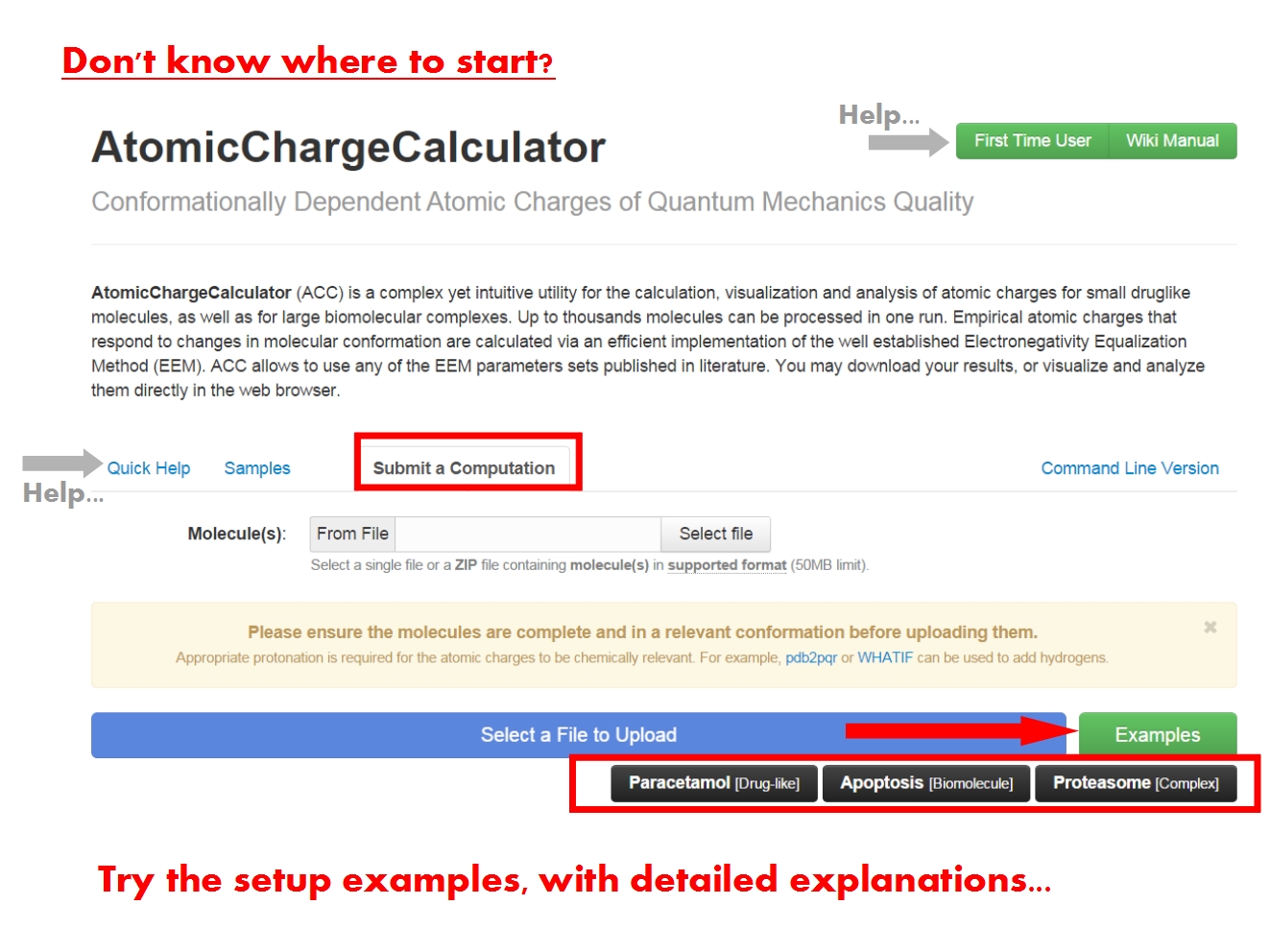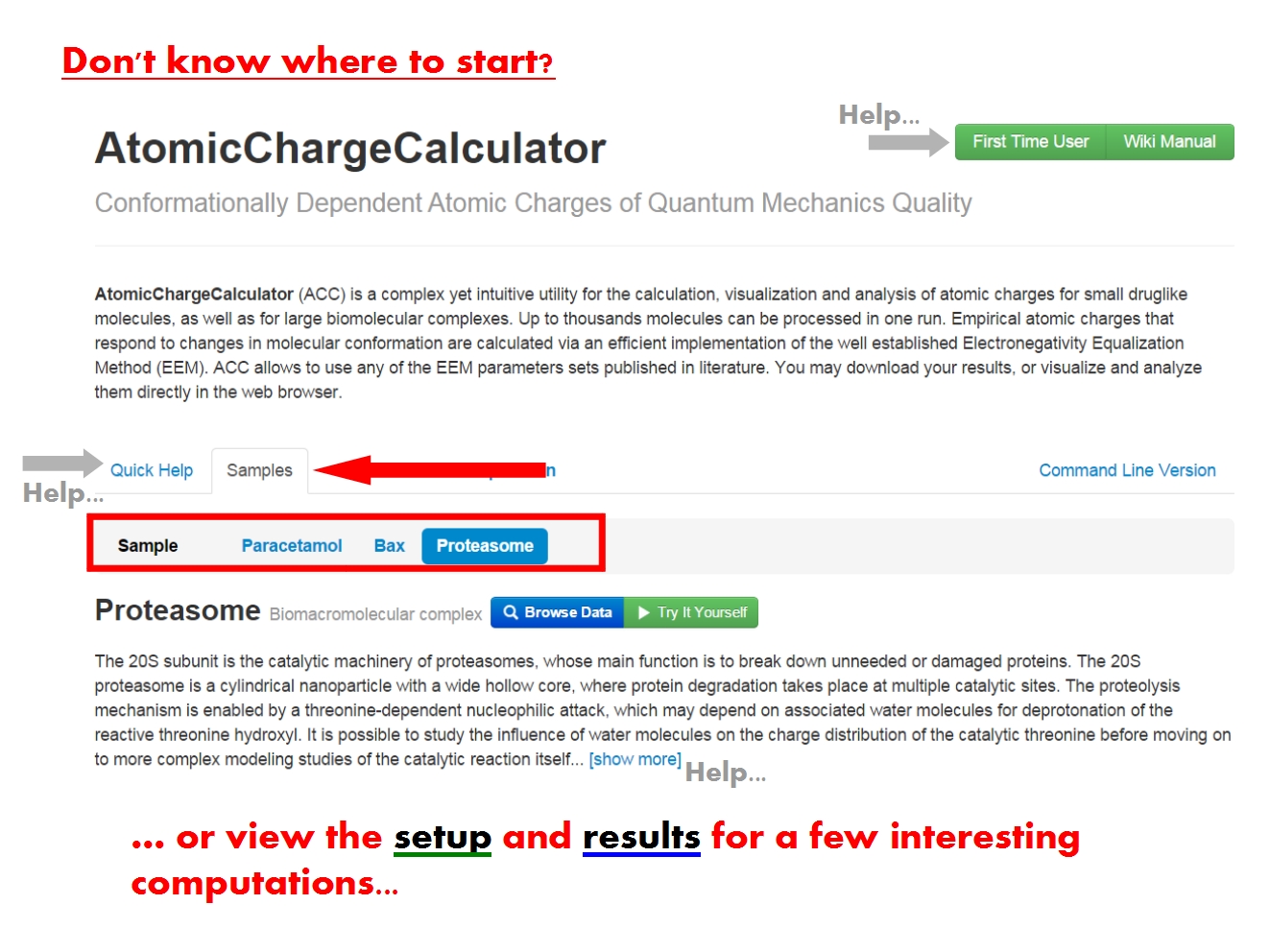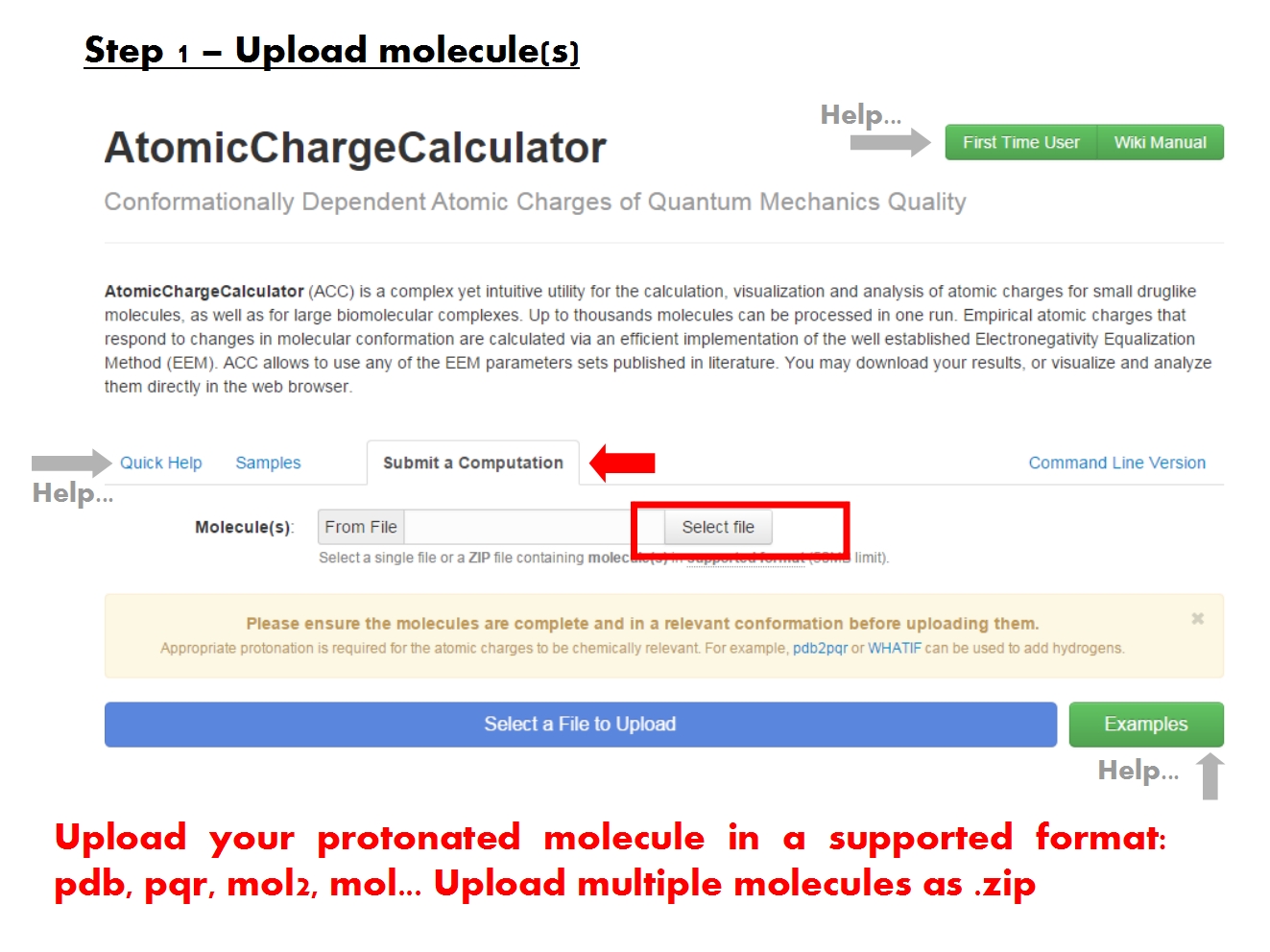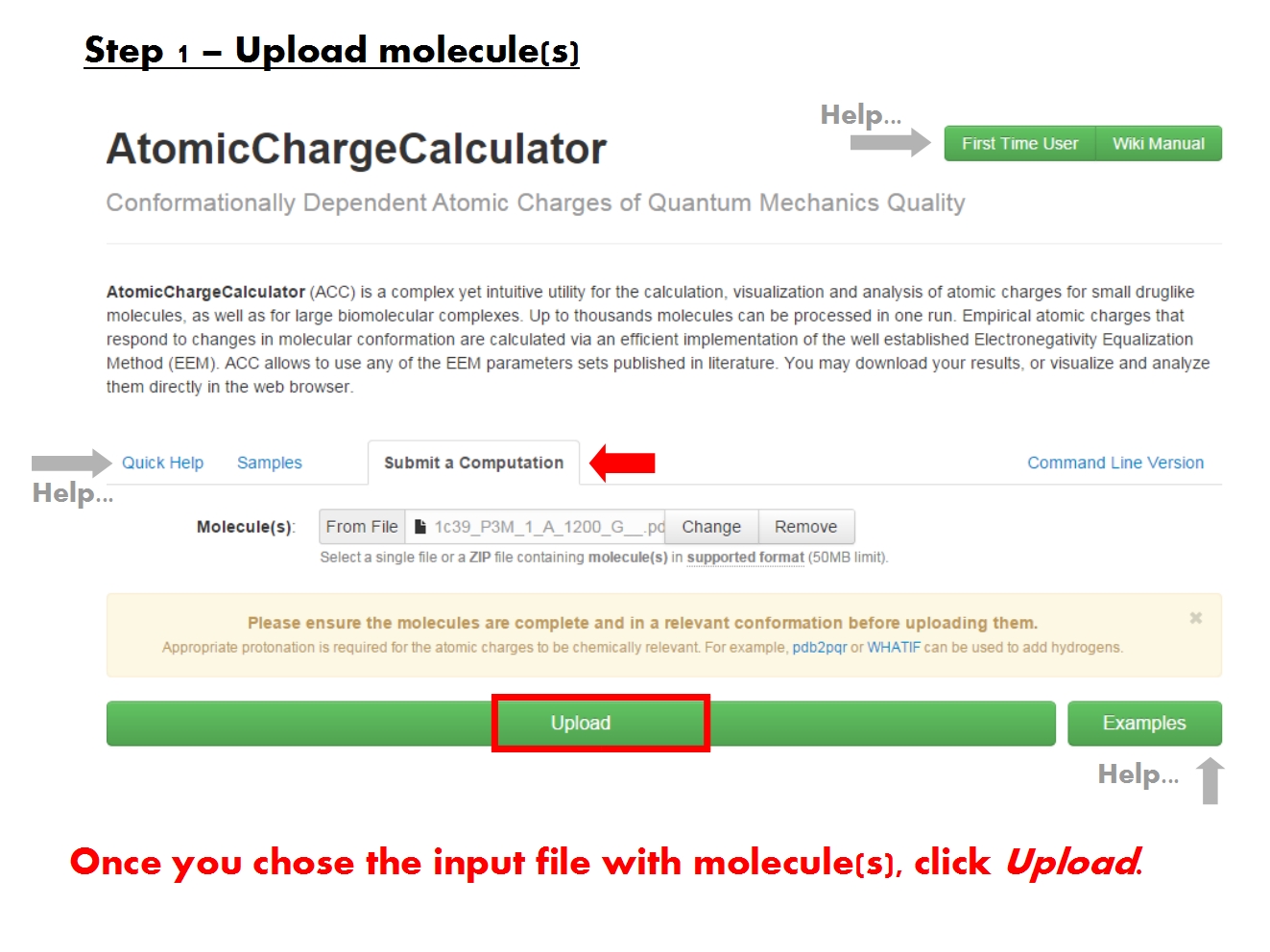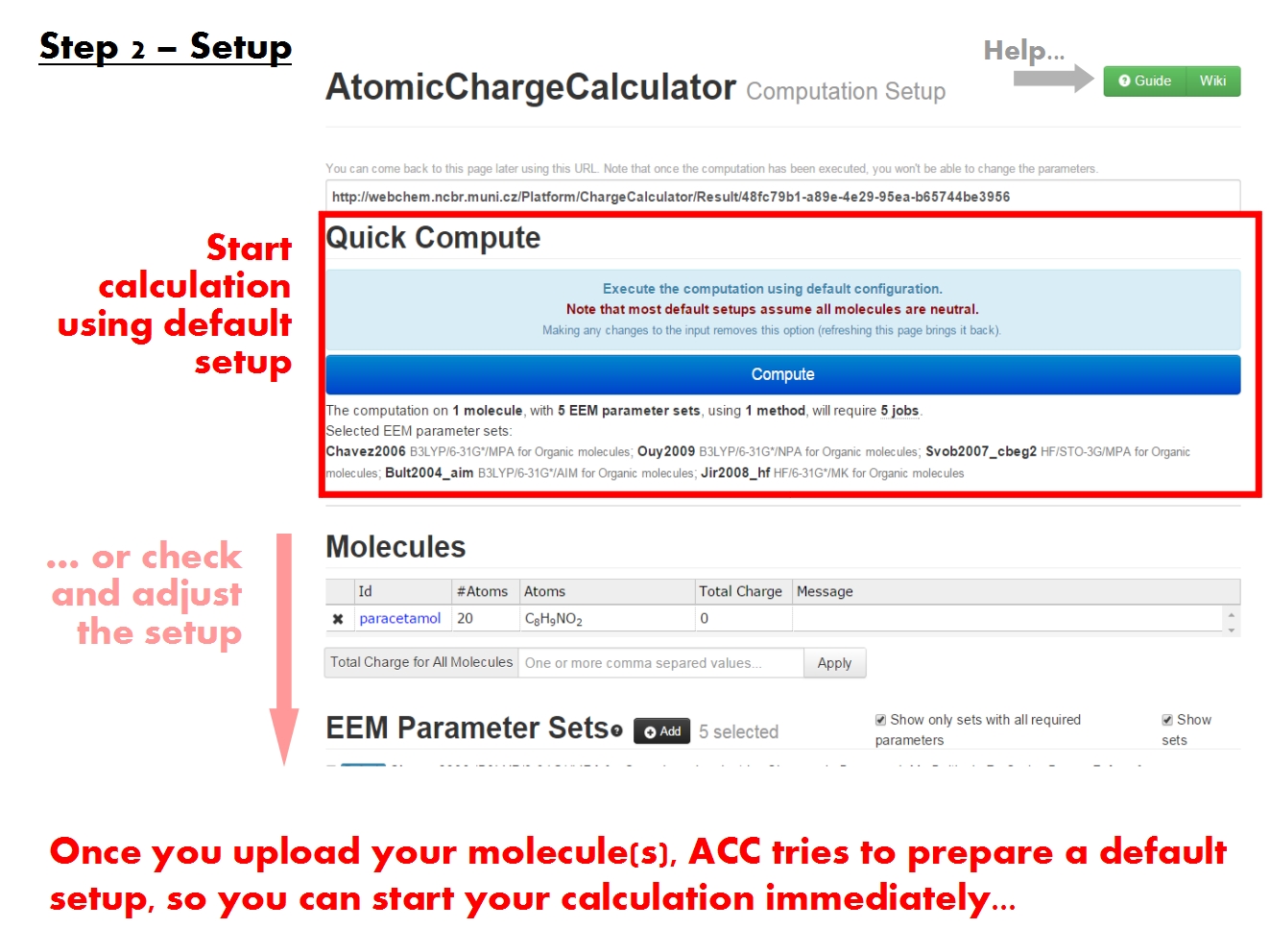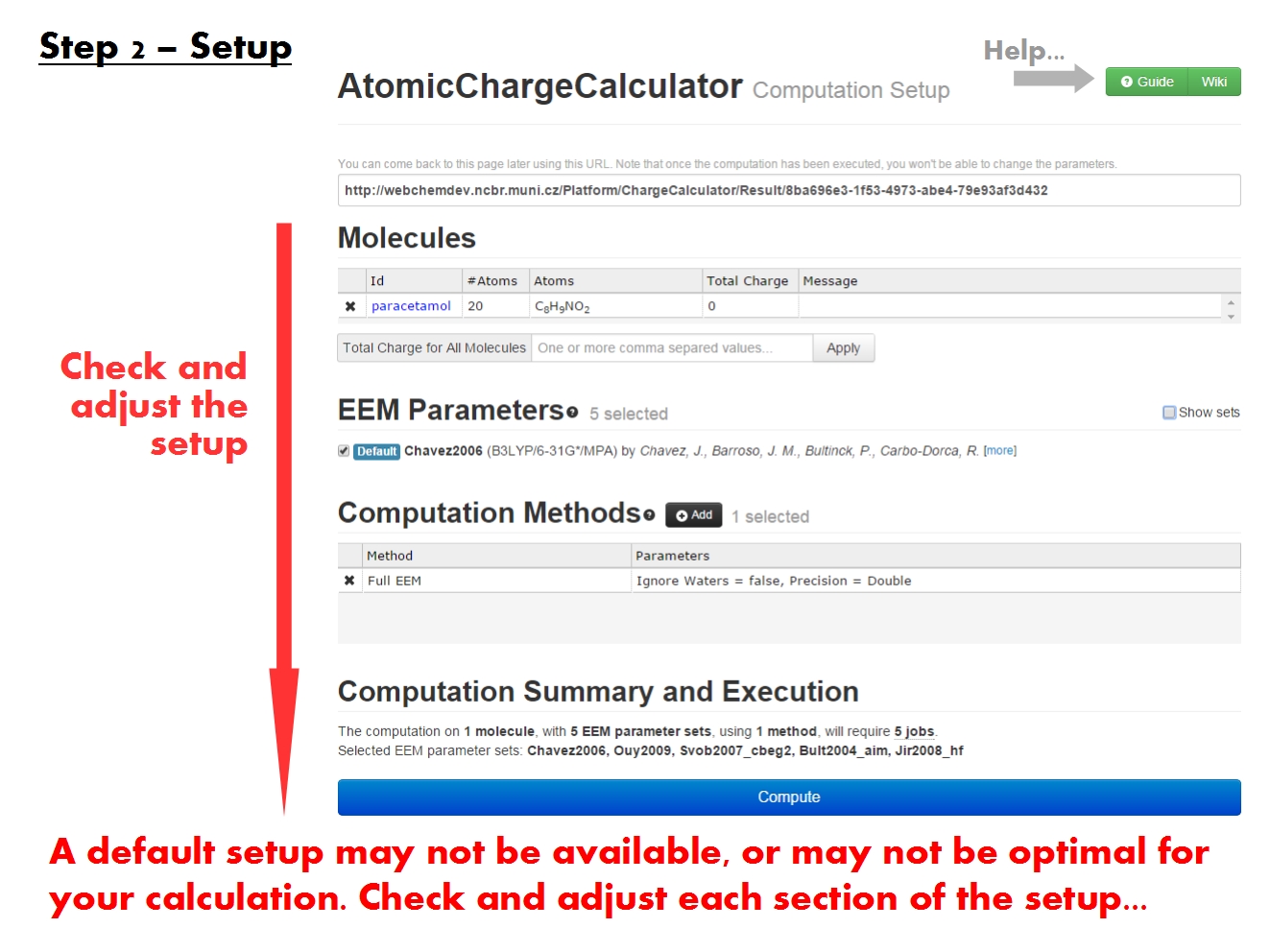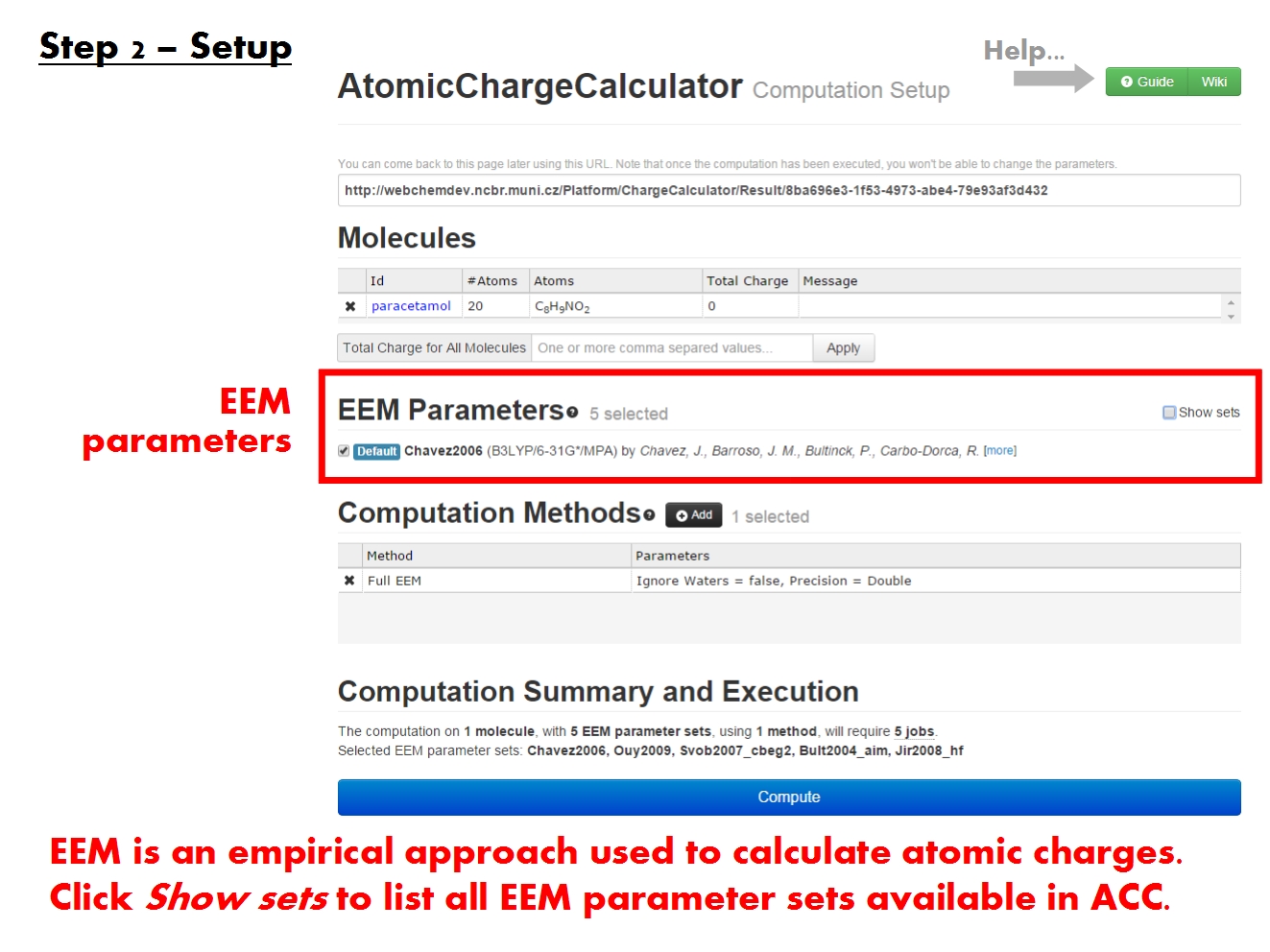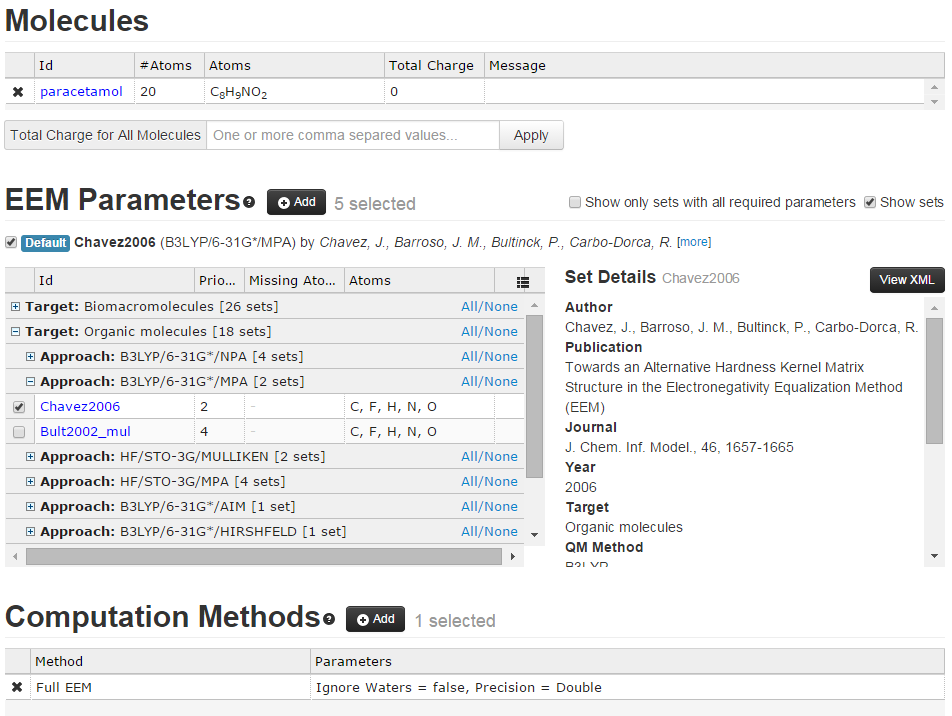ChargeCalculator:Job submission: Difference between revisions
No edit summary |
|||
| Line 42: | Line 42: | ||
|- | |- | ||
|<!--Col1-->[[File:ACC FirstTimeUserGuide 05.jpg| 650px]] | |<!--Col1-->[[File:ACC FirstTimeUserGuide 05.jpg| 650px]] | ||
|<!--Col2-->[[File:ACC FirstTimeUserGuide | |<!--Col2-->[[File:ACC FirstTimeUserGuide 06.jpg| 650px]] | ||
|- | |- | ||
|<!--Col1-->Upon uploading the molecule(s), ACC parses the molecular structure and tries to prefill the submission form with suitable default settings. | |<!--Col1-->Upon uploading the molecule(s), ACC parses the molecular structure and tries to prefill the submission form with suitable default settings. | ||
|<!--Col2--> | |<!--Col2-->Check and adjust whatever default settings you find unsuitable. | ||
|} | |} | ||
ACC generally tries to prefill the setup form with suitable options based on the molecule(s) you uploaded. It commonly happens that you can start the calculation immediately after loading the molecule. Nonetheless, the setup has a few critical | ACC generally tries to prefill the setup form with suitable options based on the molecule(s) you uploaded. It commonly happens that you can start the calculation immediately after loading the molecule. Nonetheless, the setup has a few critical sections you should check and maybe adjust before proceeding. | ||
==Set total charge== | ==Set total charge== | ||
[[File:ACC FirstTimeUserGuide | [[File:ACC FirstTimeUserGuide 07.jpg|thumb|right|650px|The total molecular charge correlates with the number of unsatisfied valences in the molecule. Make sure to assign the appropriate total charge for all non-neutral molecules you uploaded.]] | ||
The total molecular charge quantifies the amount of electron density that will be distributed across the molecule during the EEM calculation. The total molecular charge plays an important role in the quality of the '''ACC''' results. By default, '''ACC''' assumes that all molecules are neutral. If this is not the case for your molecule(s), you must indicate so in the appropriate field. For each non-neutral molecule you uploaded, write the appropriate total charge value in the ''Total charge'' column. If all molecules you uploaded have the same charge, use the ''Total Charge for All Molecules'' field, and click ''Apply''. | The total molecular charge quantifies the amount of electron density that will be distributed across the molecule during the EEM calculation. The total molecular charge plays an important role in the quality of the '''ACC''' results. By default, '''ACC''' assumes that all molecules are neutral. If this is not the case for your molecule(s), you must indicate so in the appropriate field. For each non-neutral molecule you uploaded, write the appropriate total charge value in the ''Total charge'' column. If all molecules you uploaded have the same charge, use the ''Total Charge for All Molecules'' field, and click ''Apply''. | ||
| Line 73: | Line 73: | ||
{| class="wikitable" border="1" style="margin: 1em auto 1em auto;" | {| class="wikitable" border="1" style="margin: 1em auto 1em auto;" | ||
|- | |- | ||
|<!--Col1-->[[File:ACC FirstTimeUserGuide | |<!--Col1-->[[File:ACC FirstTimeUserGuide 08.jpg| 650px]] | ||
|<!--Col2-->[[File:ACC EEM sets.png| 650px]] | |<!--Col2-->[[File:ACC EEM sets.png| 650px]] | ||
|- | |- | ||
| Line 89: | Line 89: | ||
==Pick computation method== | ==Pick computation method== | ||
[[File:ACC FirstTimeUserGuide | [[File:ACC FirstTimeUserGuide 09.jpg|thumb|right|650px| In addition to classical EEM, '''ACC''' offers two time and memory efficient EEM implementations. Please use ''EEM Cutoff'' for systems with tens of thousands of atoms, and ''EEM Cutoff Cover'' for larger systems, in both cases with a ''Cutoff Radius'' parameter of at least 8.]] | ||
The default computation includes all atoms in the system and solves the entire EEM matrix in double precision. For very large systems you may need to resort to one of the time and memory efficient EEM implementations specifically tailored for such systems (check the [[ChargeCalculator:Theoretical_background | Theoretical background ]] for more details). By default, '''ACC''' tries to suggest a computation method suitable for the molecule(s) you uploaded. | The default computation includes all atoms in the system and solves the entire EEM matrix in double precision. For very large systems you may need to resort to one of the time and memory efficient EEM implementations specifically tailored for such systems (check the [[ChargeCalculator:Theoretical_background | Theoretical background ]] for more details). By default, '''ACC''' tries to suggest a computation method suitable for the molecule(s) you uploaded. | ||
| Line 99: | Line 99: | ||
If your system is solvated or includes a few key water molecules, you may want to run parallel calculations with and without the water molecules (tick the ''Ignore Waters'' option), to see how water can affect the charge distribution in the biomolecule. | If your system is solvated or includes a few key water molecules, you may want to run parallel calculations with and without the water molecules (tick the ''Ignore Waters'' option), to see how water can affect the charge distribution in the biomolecule. | ||
<br style="clear:both" /> | <br style="clear:both" /> | ||
[[File:ACC FirstTimeUserGuide 11.jpg|thumb|right|650px| To find out what the settings mean, why they are required and how they influence your calculation, take advantage of all the help available as interactive guides and tool tips.]] | |||
Finally, if you don't know what something means or how it works, don't forger that there is plenty of help available directly on the '''ACC''' web pages. Hover the mouse over any keyword you do not understand to reveal a useful tool tip. Click on any of the buttons marking the interactive guides. Note that such guides are available for the entire '''Setup page''', and for any of its sections. Additional specialized guides are provided for the ''Sample'' calculations. | |||
=Start computation= | =Start computation= | ||
Revision as of 16:32, 16 December 2014
The ACC submission page contains a brief description of ACC, and is further organized into several tabs. Since this is your first contact with ACC, the support tabs Quick Help and Samples help you get started, with basic information and examples of ACC use cases.
You may submit an atomic charge calculation in 3 easy steps, namely: upload your molecule(s), setup the computation, and finally start the calculation.
Upload molecules
ACC is able to read the molecular structure and charge information from the most common file formats. Nonetheless, because it was designed to handle molecules of all kinds and size, ACC generally requires that the input files follow the formal guidelines established for each format.
In order to produce chemically relevant atomic charges using EEM, it is necessary that the structure of the molecule be complete. No crucial parts should be missing. If parts of the structure are missing, appropriate cappings should be included. All protons should be present according to the relevant protonation state. Since ACC does not currently include functionality for editing the molecular structure, you must address these issues prior to uploading the molecule into ACC. For example, you may use a server like pdb2pqr to assign protonation states, add protons and subsequently estimate the total molecular charge.
ACC does check valences, and produces a missing H warning if they are not satisfied. Despite the warning though, ACC allows to proceed with the charge calculation step, as it might not always be possible to obtain a perfect structure (e.g., when working with low resolution structures of extremely large complexes). The results from such calculations may not have chemical meaning in their absolute values, but they can be very useful when comparing sets of charges (open vs closed conformation, free vs bound state, etc.).
Input files generally contain atom type information. Many different atom type schemes are used in different modeling projects. Moreover, many times the output is not even standardized between different applications implementing the same atom type scheme. ACC attempts to be a general utility, and currently implements only the detection of chemical elements. If the atom types in the input file differ from chemical elements, ACC will report them as unknown chemical elements, and these atoms will be skipped during the EEM calculation (they will not contribute to the EEM matrix ). A similar problem will arise if the atom type information is not found at the expected place in the file. In the future, a more complex parsing algorithm may be implemented in ACC in order to cover the most common atom type schemes (e.g., AMBER, OPLS, etc.). Currently, the atom type parsing problem can be worked around either by uploading input files which adhere to the formal guidelines for their respective formats and contain atom types according to chemical elements, or by creating an EEM parameter set with special parameters for those atom types which ACC finds problematic.
If the chain ID is not explicitly included in the input file, but the molecule contains multiple chains with overlapping residue serial numbers, the results will not be meaningful for the affected residues, and possibly even in the vicinity of these residues. ACC provides check chain ID warnings both before and after the computation if this problem is detected, so that the input file can be corrected.
If bond information is not explicitly included in the input file, ACC will attempt to compute this information based on the molecular structure. This algorithm may assign wrong bond information when interatomic distances vary significantly from the expected norms. This behavior may only affect calculations using EEM parameter sets which distinguish between atom types based on bond information.
Setup computation
Once you have uploaded your molecule(s), ACC parses the molecular structure and redirects you to the ACC Setup page. Note that at this point a unique URL has been generated on the ACC server, and assigned to your computation. You may use this URL during calculation setup, execution or completion to access all the data associated with your ACC computation.
ACC generally tries to prefill the setup form with suitable options based on the molecule(s) you uploaded. It commonly happens that you can start the calculation immediately after loading the molecule. Nonetheless, the setup has a few critical sections you should check and maybe adjust before proceeding.
Set total charge
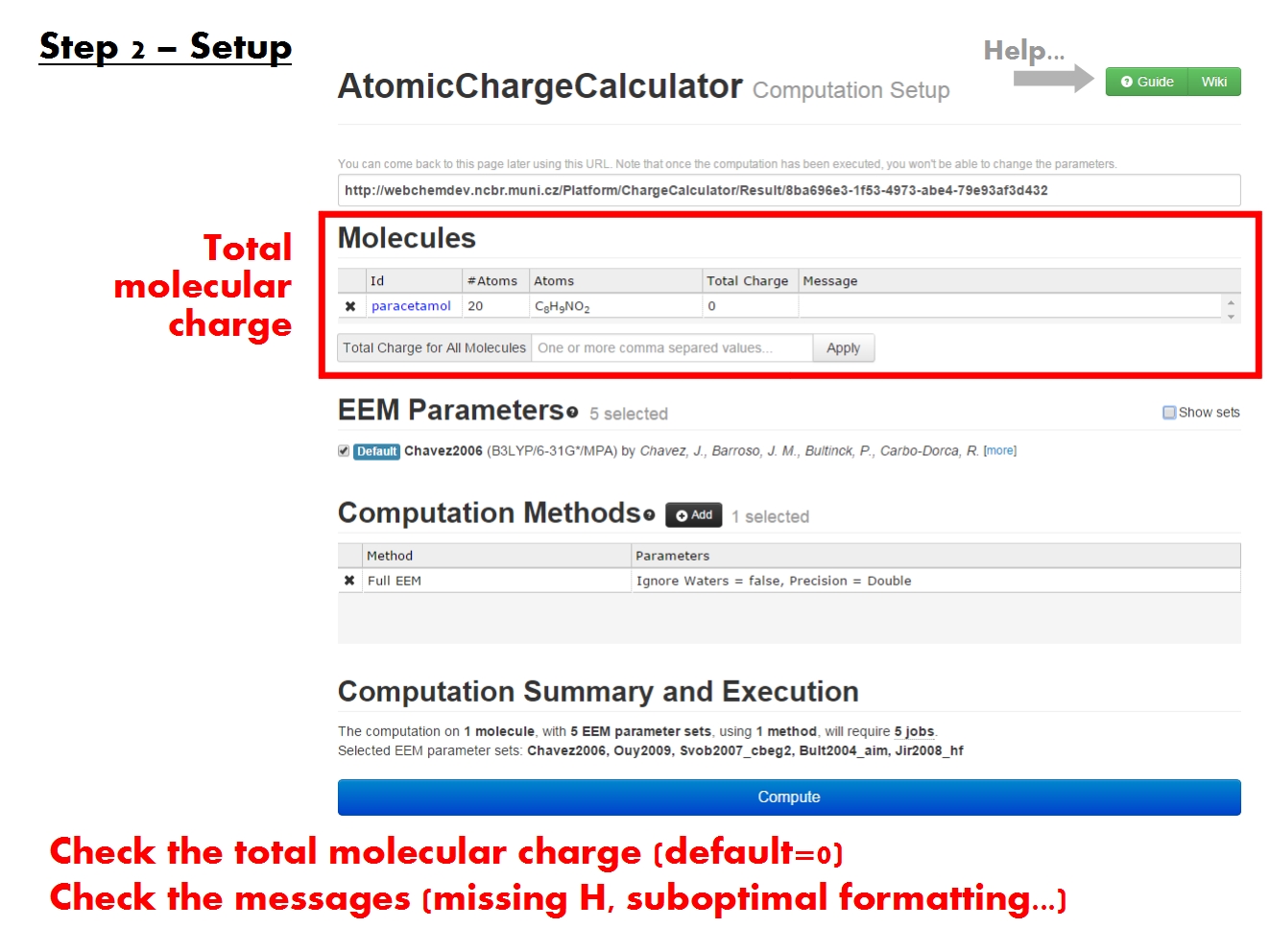
The total molecular charge quantifies the amount of electron density that will be distributed across the molecule during the EEM calculation. The total molecular charge plays an important role in the quality of the ACC results. By default, ACC assumes that all molecules are neutral. If this is not the case for your molecule(s), you must indicate so in the appropriate field. For each non-neutral molecule you uploaded, write the appropriate total charge value in the Total charge column. If all molecules you uploaded have the same charge, use the Total Charge for All Molecules field, and click Apply.
The total molecular charge must be in tune with the structure of the molecule. Specifically, it correlates with the number of unsatisfied valences in the molecule. For this reason, ACC checks valences, and produces a missing H warning if they are not satisfied, suggesting the molecule may not be neutral. You should always check the Message column.
Pick EEM parameters
The Electronegativity Equalization Method (EEM) is the procedure by which atomic charges are calculated. EEM employs special parameters for each type of atom. An EEM parameter set, or simply set, was developed for a certain charge definition, and contains parameters for certain atom types (H,C,N,O, halogens, metals, etc, depending on the target molecules).
Many EEM parameter sets have been published in literature, and are available here as built-in sets. ACC tries to recommend an EEM parameter set suitable for the molecules you uploaded. It may be that the default ACC selection is not optimal for you, or you wish to try several EEM parameter sets. Click more or Show sets for a table with the full list of sets available in ACC.
The applicability domain of a given EEM parameter set is generally limited to the target molecules, and closely related to the applicability domain of that particular approach. This is why the table with EEM sets is organized according to the class of target molecules (organic molecules, biomolecules), and the charge definition, or approach used during the development of the parameters (population analysis, QM theory level). Click on the name of any set to get more info (citation, target molecules, approach) in the panel on the right side of the table. In order to view the parameters themselves, click View XML.
In the table with EEM sets, check the column Atoms to see which atom types are covered by each set. ACC will let you know if a given set does not contain parameters for some atom types present in the molecule(s) you uploaded. Look for the orange highlight which marks missing parameters in the column Missing atoms. If parameters are not available for a certain atom type, these atoms will be skipped during the EEM calculation. Note that if built-in EEM sets with all necessary parameters are available, the rest of the sets are hidden by default. To reveal them, untick the option Show only sets with all required parameters at the top of the table with sets.
Select one or more EEM parameter sets for your computation. Note that each EEM parameter set will be associated with a different ACC job or set of jobs.
You may also add your own set of EEM parameters if you are unhappy with the built-in sets available. Click the Add button at the top of the EEM Parameters section to open a separate window where you can fill in the values of the parameters into a predefined XML template suitable for ACC. Make sure to keep the established XML syntax and give your set by a unique name, then click the Add button. ACC will verify the syntax and let you know if you need to change anything. Your new set will be available in the table, along with the built-in sets.
You can use the add function in order to generate modified versions of built-in sets. Click on the built-in set of interest, then View XML on the panel to the right. Copy/paste the content into the Add window and make your modifications. For example, if you copy the parameters for H into the same set, and modify the Element name tag to say P, you have added EEM parameters for phosphorus which are identical to the EEM parameters used for hydrogen. Save this EEM parameter set under a unique name, and it will be available in the table.
This strategy is very useful if the EEM parameter set you wish to use does not contain parameters for certain atom types present in your molecule(s), or if ACC could not read chemical elements from the atom type information in the input file, and reported an unknown chemical elements warning. You must always check the Message column in the table with molecules, to ensure that all relevant atoms are included appropriately in the calculation.
Pick computation method
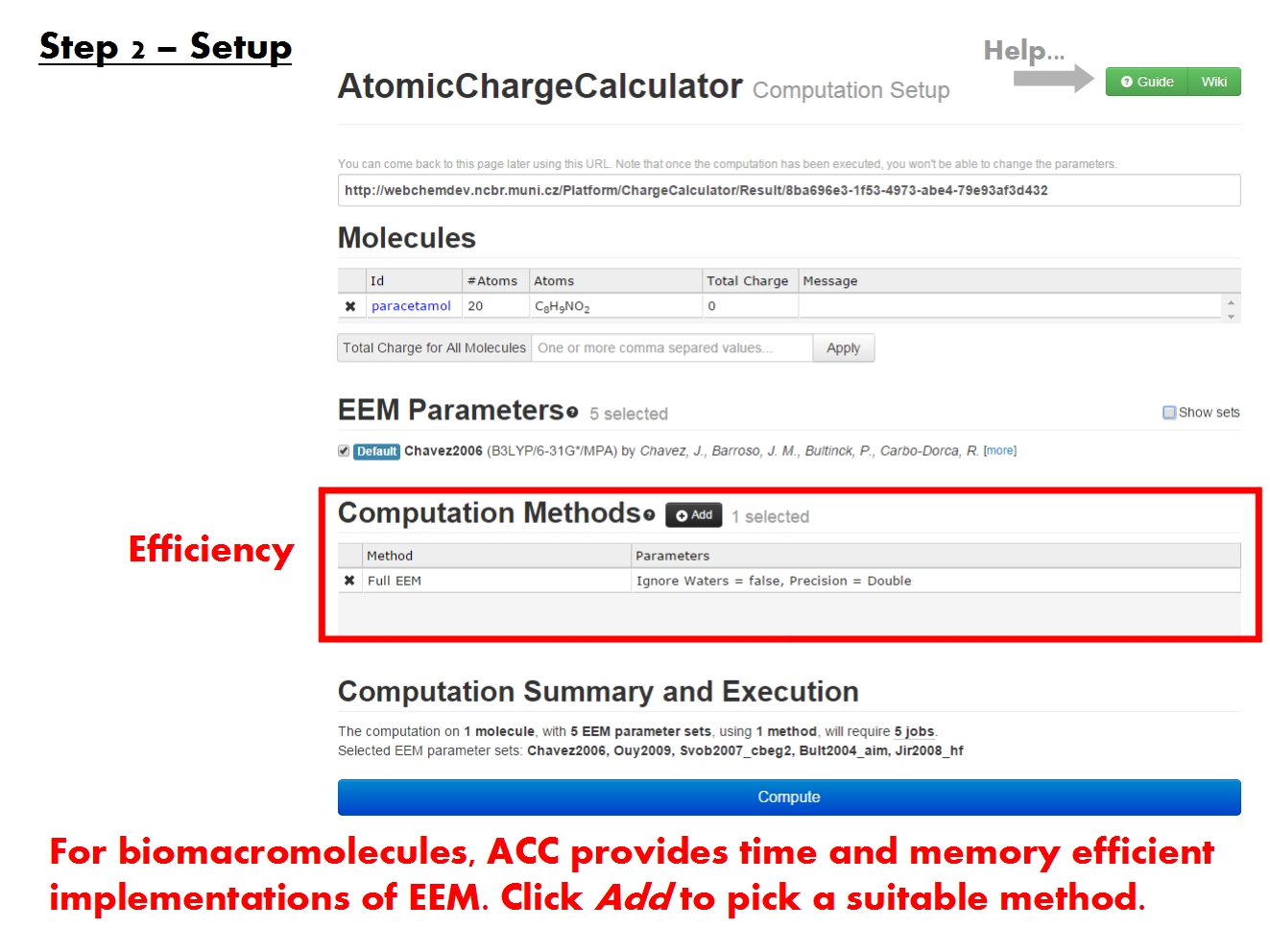
The default computation includes all atoms in the system and solves the entire EEM matrix in double precision. For very large systems you may need to resort to one of the time and memory efficient EEM implementations specifically tailored for such systems (check the Theoretical background for more details). By default, ACC tries to suggest a computation method suitable for the molecule(s) you uploaded.
You may change the method chosen by default, and add one or more methods of your choice using the Add button at the top of the Computation Methods section. Note that each unique method configuration added to the list will result in an additional ACC job, or set of jobs.
Even for molecules containing several thousands of atoms, our implementation of EEM is very time efficient, and you may use the method labeled as EEM. For systems with tens of thousands of atoms, you will probably need to pick EEM Cutoff, and a reasonable value for the Cutoff Radius parameter (we recommend a minimum of 10). A biomolecular complex with hundreds of thousands of atoms makes good use of the method EEM Cutoff Cover with a Cutoff Radius of 12 and single Precision.
If your system is solvated or includes a few key water molecules, you may want to run parallel calculations with and without the water molecules (tick the Ignore Waters option), to see how water can affect the charge distribution in the biomolecule.
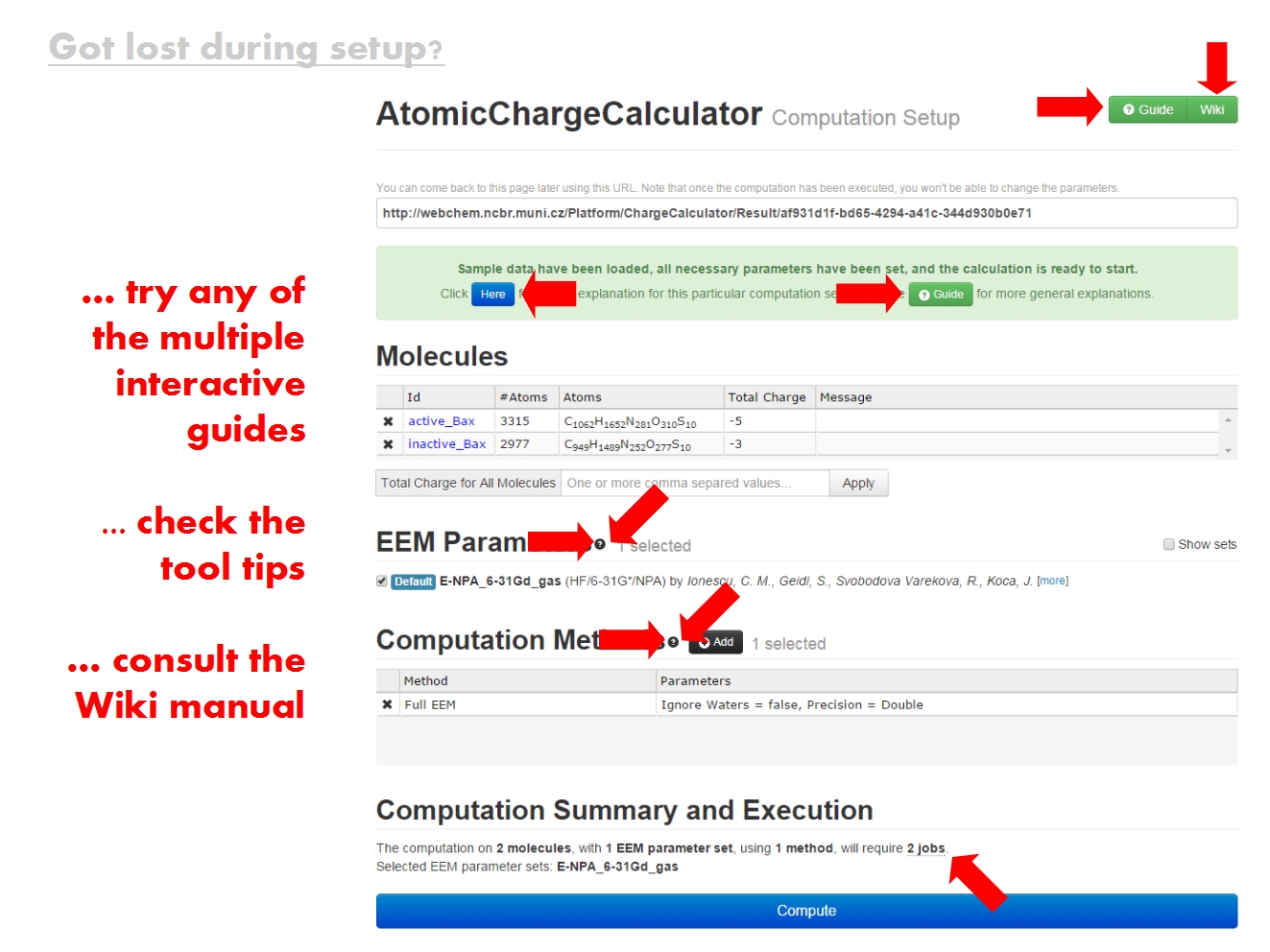
Finally, if you don't know what something means or how it works, don't forger that there is plenty of help available directly on the ACC web pages. Hover the mouse over any keyword you do not understand to reveal a useful tool tip. Click on any of the buttons marking the interactive guides. Note that such guides are available for the entire Setup page, and for any of its sections. Additional specialized guides are provided for the Sample calculations.
Start computation
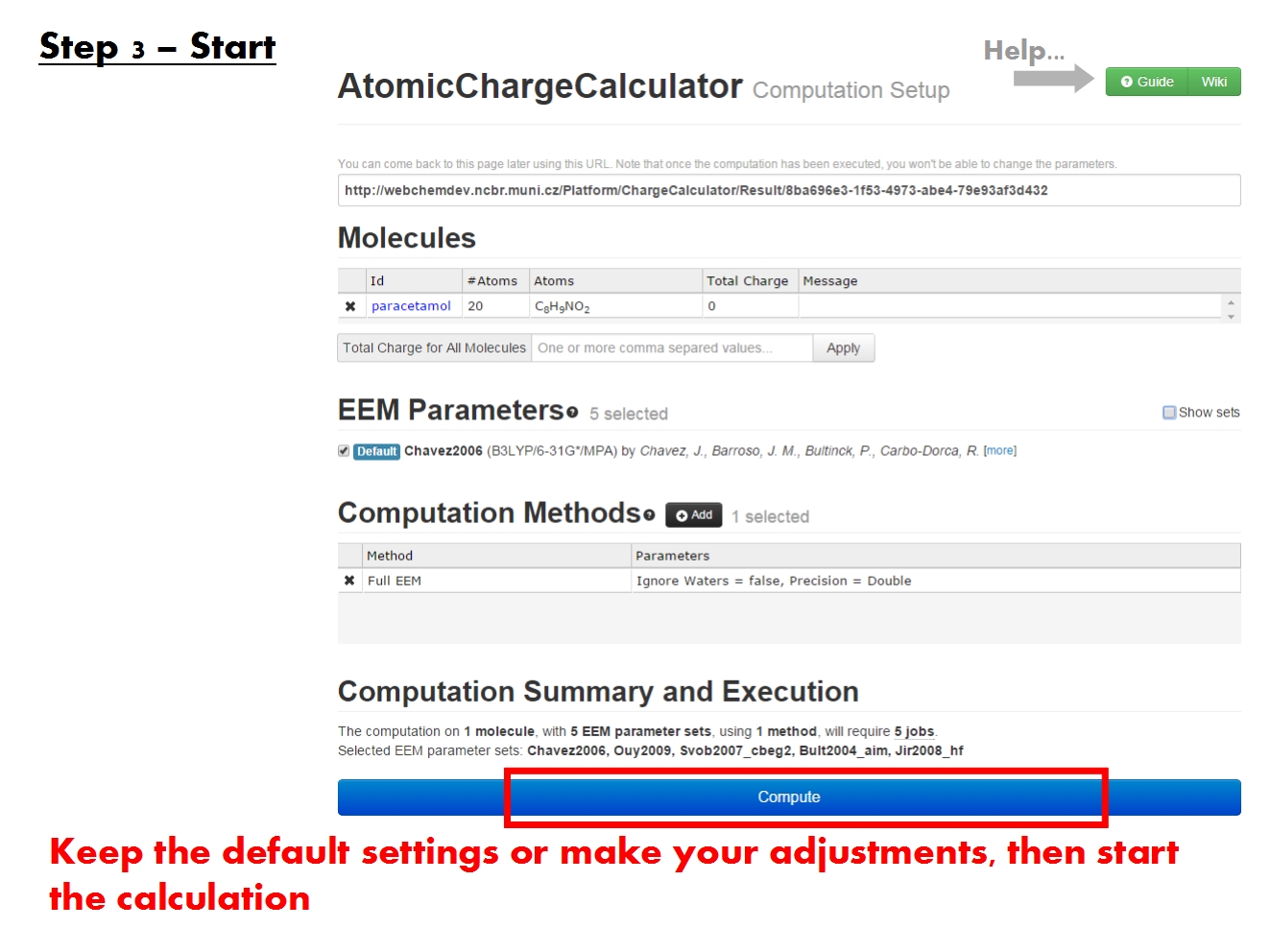
Before you launch the calculation, check out the summary of the setup. One computation may require more than one job. Each job is uniquely defined by the molecule and its total charge, the set of EEM parameters, and the computation method. The number of the jobs thus depends on the number of molecules uploaded, along with the number of sets and methods chosen. Within a single computation, each job may use a different amount of time and memory resources, depending on the size of the molecule and the complexity of the computation method employed.
If you are satisfied with the computation setup, click Compute to launch the calculation. You may always check the progress of the calculation in real time, or at a later time using the same URL as for the Computation Setup page.
The complete list of keywords involved in the setup of ACC calculations is available in the Index. Return to the Table of contents.
